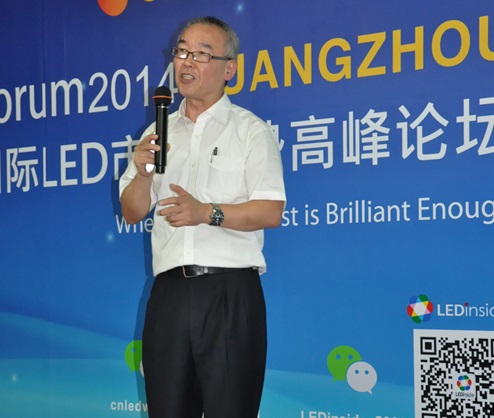This is the year of the flip chip, according to Dr. Guoqing Tang, Samsung LED China General Manager and Sr. Vice President who presented at LEDforum 2014 at Guangzhou International Lighting Exhibition on June 11.
 |
|
Dr. Guoqing Tang, Samsung LED China General Manager and Sr. Vice President presenting during LEDforum at the Guangzhou International Lighting Exhibition on June 11. |
Flip chips have risen in popularity over the past few years and have been especially well received by high power indoor and outdoor lighting application market. One of Samsung’s Korean clients in the LED industry only uses flip chip packaging because of its reliability.
The reason behind flip chip’s popularity in recent years is that it is safer and more reliable than face-up LEDs with the same brightness. Flip chip technology has some obvious advantages over other packaging methods, explains Dr. Tang. One advantage is that it is able reduces the need for sapphire substrate in heat dissipation and can withstand high voltage. Flip chips are also smaller making them easier to assemble optically. Additionally, flip chips have better heat dissipation capabilities, thereby increasing chip lifespan. Static resistance capacities are also improved in flip chips and has laid the foundation for future package technology developments.
Tang introduced Samsung’s newest flip chip LED packages and modules during LEDforum. The company’s new flip chip LED packages LM131A is mainly between 0.8W-1W, and is a 1313 LED that has wire free lead frame. It can provide a high luminous flux of 122lm/W (300mA, color temperature of 5000K). Samsung applied phosphor film technology that is usually applied to high power bulbs. Compared to conventional mid-powered package products, the product has better color tolerance adjustment control, within 3-step MacAdam ellipse. Moreover, the new flip chip products can also lower costs compared to conventional leadframe products. In comparison to 5630 LED prices the new flip chip products has a 30 to 50 percent price reduction range.
Samsung’s flip chip on module (FCOM) series is designed for use in bulbs, downlights, daylight fluorescent tubes, spot lights, MR16, PAR 30 and PAR 38. FCOM luminous flux can reach 122lm/W. Samsung is currently considering integrating a constant-current driver IC with a light board to create a lighting engine module. This will be able to reduce the need for an outside power source, save luminaire space, and lower cost.
The term flip chip comes from how the chip is manufactured. Unlike conventional gold-wire bonding, flip chips use the ball grid array (BGA) technique. In traditional packaging, the wire bonding process is done face up on the dielectric substrate. This method is reversed when making flip chips, however, where the wire bonding is down face down on the substrate. Therefore, the term flip-chip.
Outlook for the advantageous flip chips in the LED market looks bright, said Roger Chu, Research Director at LEDinside. Chu estimates that flip chip LED market scale will see substantial growth over the next five years, where market scale will grow from US $1.5 billion in 2013 to US $5.5 billion by 2017.
Flip chips could start being introduced into TV backlight application in large volumes during the second half of this year, said Chu. There will be opportunities for further cost drops as LED manufacturers invest in flip chip LED technology.
Performance advantages of flip chip technology and prosperous market outlook spurred many large chip and package manufacturers to launch related products. In China, main flip chip manufacturers include APT Electronics, HC SemiTek, TsingHua TongFang, San’an Optoelectronics, and Elec-Tech International (ETI).
Taiwanese manufacturer Genesis Photonics Inc. (GPI) delved into flip chip technology three years ago, and has applied for related patents. GPI launched MATCH LED series in 2013, which is successfully applied in the indoor, outdoor and automotive lighting field. Another Taiwanese manufacturer Lextar has recently released two large flip chip product series – flip chip CoB and White Chip. Chuanghua and Epistar are also active in this area.
“Aside from flip chips, CoB is another area that will become a huge trend in the future, since CoB has plenty of advantages in downlight applications,” said Tang.
How LED manufacturers plan to segment the market in the future is very important. This includes product, client, and channel categorization. “Manufacturers will only see growth by making good products and selecting the right clients,” said Tang.
(Author: Sophie Liu, Editor, LEDinside China, Translator: Leah Allen, Editor, LEDinside)












